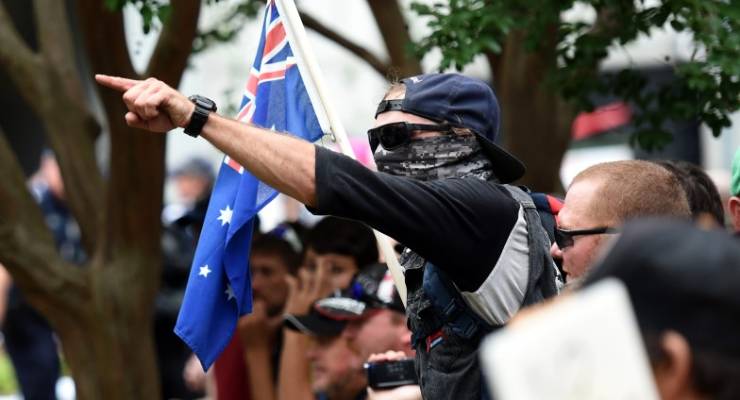
Anyone rushing to examine the list of submissions about extremism to the Parliamentary Joint Committee on Intelligence and Security will be sorely disappointed. There are no great, novel insights.
But the inquiry into radicalisation, prompted in part by Labor’s Kristina Keneally, serves to highlight threats both known and not so known. It may be dwelling on the fringes, but there is no doubt that dangerous extremism is alive and well in some quarters.
Let’s consider the analysis of the sources of possible terrorist threats. Terrorist networks such as al-Qaeda and their respective affiliates remain a key threat to national security. This is unchanged, almost two decades on from the tragic September 11 attack.
The Australian Security Intelligence Organisation’s (ASIO) pithy six-page submission names the two proscribed networks — Islamic State and al-Qaeda — as having a continuing influence that requires monitoring.
Several submissions make the point that Australia has radicalised individuals that have been imprisoned for their participation in Islamist terror plots that are due for release over the next five years.
Do they continue to pose a terror threat to Australia? That is a question the judicial system and law enforcement must soon face.
Some of the individuals that have been released at the conclusion of their terms have breached control orders designed to ensure they do not fall into past patterns of behaviour. The submission from the Australian Federal Police (AFP) observes that its high-risk terrorist offenders teams have arrested six convicted terrorist offenders and charged them with breaching control orders over the past eight months.
One such arrest occurred in January when a 25-year-old man from Sydney with an alignment with Islamic State allegedly breached a control order that prohibited him accessing propaganda material online.
But what about extreme right-wing groups and individuals? ASIO, the AFP and Victoria Police have all maintained a greater focus on the growth of far-right groups than in the past.
Crikey has previously reported the speed in the growth of far-right groups online and the fact that booting extremists from Facebook and Twitter has led them to find other digital camps to peddle their pernicious ideas.
The AFP notes that law enforcement agencies are aware of this online environment and that members of joint counter-terrorism taskforces have acted to disrupt far-right extremist activity.
There is no identification of specific far-right groups in the text of submissions and the only individual with far-right leanings named is Phillip Galea. Galea was sentenced to 12 years imprisonment in November last year after being found guilty of being in possession of materials that would facilitate acts of terror and also preparing or planning for a terror attack.
Submissions made to the committee also refer to extreme-left terrorism, with ASIO noting that violence on the far-left of the political continuum is not prominent at the current time.
A lack of prominence, however, does not mean that activity on the part of extreme-left actors does not exist. The Victoria Police submission observes that the activity of far-right extremists appears to have a “symbiotic relationship” with left-wing extremist threats.
“In addition to violent conflict at organised [right-wing extremist] events and public demonstrations, Victorian-based [left-wing extremist] movements and individuals are mimicking overseas based movements (such as ANTIFA) to justify the use of violence to promote civil unrest and target perceived enemy groups,” the Victoria Police submission says.
The past 12 months has also seen different types of extremists seek to exploit the coronavirus pandemic to push their various warped world views — from anti-government or “sovereign citizens” to anti-5G and anti-vaccination.
“[These groups] are seeking to exploit social and economic dislocation; and their extremist ideology has been spreading more quickly and widely as Australians spend more time online engaging with like-minded individuals,” ASIO observes.
These kooks only attract the attention of organisations such as ASIO when their activities switch from online discourse and propaganda to the planning and execution of violent activities.
Crikey has widely reported on the way in which encrypted applications have led to the rapid growth of fringe movements. ASIO’s submission notes that the inability to monitor various groups and individuals on these platforms means they are unable to get adequate intelligence in nine out of 10 critical cases.
That last point is going to be crucial moving forward.








What a disgraceful justification of our eroded civil liberties.
Almost all cases mentioned here are thought crimes, not actual crimes.
What is going on Crikey?!?!
“control orders designed to ensure they do not fall into past patterns of behaviour” – patterns of behaviour??
“control order that prohibited him accessing propaganda material online” – not even a thought crime, a reading crime … as defined by some secret spook.
“being in possession of materials that would facilitate acts of terror and also preparing or planning for a terror attack” – so now it’s routine to prosecute on presumption of future action …
“members of joint counter-terrorism taskforces have acted to disrupt far-right extremist activity” – so secret police forces are taking it upon themselves to ‘disrupt’ the activities of people based on their political outlook?
“Victorian-based [left-wing extremist] movements and individuals are mimicking overseas based movements (such as ANTIFA) to justify the use of violence to promote civil unrest” – apart from this being a complete mischaracterisation of ANTIFA, civil unrest is often called exercising political rights to demonstrate, but our secret arbiters of thought crime equate demonstrating with “violence”
Yeah, nail-biting stuff Tom: genuine click-bait for the 2020s reporter.
Is there a pattern? Religion, in cases, but anything else? Given (e. g) unaffordable housing and homelessness along with increased automation perhaps the fobbing off isn’t working.
Yeah, the most recent report from the ASD will fix it. Jot something on that when the mood takes you.
I suspect agencies such as ASIO employ extreme right wing sympathisers.
A recent article in the Oz (27/02) led with concerns re R wing terrorism then the body of the article only discussed the potential perils of left wing terrorism and movements. Fascinating but predictable bias by this ultra R wing rag.
Interesting, but surely we are observing symptoms of old ideology rebranded for the 21st century, that also resonates with a broader silent majority, not just an extremist minority gaining attention?
Listen to and read their words and not only can one identify themes shared with mainstream (mostly) LNP/ON MPs and media, but the ideology the same sentiments are based upon i.e. imported from the UK/US; radical right libertarianism joined at the hip with eugenics or white nativism.
This includes old Malthusian ‘great replacement’ fears masquerading as ‘theory’ focused upon population growth, refugees and immigration, that has promoted white Christian nationalist identity to retain power.
This in turn has masked (‘owned’) government’s catering to special interests i.e. legislation rewarding libertarian corporates with low/no regulation/taxes); aka Brexit and Trump (plus a few other fringe nations not keen on ‘democracy’, freedom, liberty and equality)